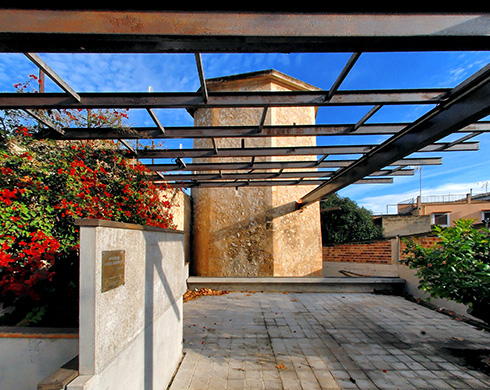Electricity in Alaró
A natural landscape is inseparable from the people who live in and form a part of it. Indeed there is no such thing as a landscape without a human eye to observe and appraise it, although man's presence inevitably alters it. Three or four thousand years ago, landscapes remained unchanging, but we no longer live in caves. From the moment that man settled in what are now the Serra de Tramuntana's municipalities, everything started to undergo an irreversible process of change: the natural setting was modified and we must accept this fact. Man's contributions over the course of history also form part of the Serra de Tramuntana's heritage. We live in the 21st century and there is no possibility of a Serra de Tramuntana without a human presence; that is, without its inhabitants and its visitors. Perhaps we should not regret this, but instead accept the human mark on the landscape as a necessary, inherent part of it and, if anything, try to adopt a more sustainable approach.
One key moment in the history of the Serra de Tramuntana was the arrival of industrialization to some of its municipalities in the early 20th century. Perhaps precisely because these mountainous spots were hard to reach, the mark that the inhabitants of some of these towns and villages made was stronger than elsewhere on the island. Two places that stand out particularly in this process of industrialization were Sóller and Alaró. In both cases, electricity was introduced and a railway line built at almost the same time. A subsequent article will look at the well-known case of Sóller. Today, however, we will focus on the much lesser known story of Alaró.

One key moment in the Serra de Tramuntana's history was the arrival of industrialization to some of its municipalities in the early 20th century
Alaró was the first municipality in Mallorca to have an urban electricity network, even before Palma. Electricity was brought to Alaró thanks to two villagers, brothers Gaspar and Josep Perelló Pol, who had a soap and oil business. Gaspar, who had travelled to Barcelona on business, was dazzled by the potential offered by the big city's electrification and he wanted Alaró to benefit from what he had seen there. His dream came true, thanks to capital that he himself invested and to the support of a handful of people from Alaró, who were convinced of the advantages that electricity represented. Overcoming the reticence of many villagers, the Perelló brothers brought experts from Catalonia and built a power station and electricity supply network that was inaugurated on August 15th 1901, coinciding with local festivities in the village. A power station tower still remains. It was restored in 2001 to mark the centenary of the inauguration.
The power station was fuelled by coal from the village's lignite mines, in front of which a railway line ran; another big landmark in Alaró's industrialization. The Palma to Inca train line, inaugurated in 1875, did not stop at Alaró. The nearest station was Consell. Five years later, two villagers from Alaró, Jaume Comes Frau and Josep Sureda Villalonga, were awarded a concession for a railway line from Alaró to the station at Consell, allowing shoes to be transported (one of the village's main industries, together with its coal mines). Alaró came to have thirty shoe factories, only one of which still remains.
Initially, due to a lack of capital, Alaró railway could not afford a steam engine. The journey to Alaró was an uphill one and the train was pulled by mules. On the way back to Consell, however, the train took advantage of a 50-metre difference in level and the force of gravity. It was not until 1922 that the railway company managed to purchase two benzene-operated engines, christened with the unusual names of Sant Cabrit and Sant Bassa in memory of the two legendary medieval figures who defended Alaró Castle from King Alfonso of Aragón's troops.
Electricity, its own railway line, coal mines, shoe factories...all of them were a source of prosperity, created at the initiative of private individuals who are barely remembered today, since Alaró, like so many other villages in the El Raiguer area, has become a kind of commuter town for people working in Palma or Inca.
Text by Jordi Martí
Translated by Rachel Waters
Did you know that...
According to newspapers of the day, the introduction of electricity aroused huge expectation throughout the whole of Mallorca. The power station and the electricity supply network's inauguration in Alaró coincided with festivities to celebrate the village's patron saint on August 15th 1901. The Town Hall organized a very full programme of events, attended by huge crowds of people from Palma and neighbouring towns and villages..
As tends to happen with all dreams, in the end you are forced to wake up. Josep Perelló died in 1906 and Gaspar was left the sole owner, after buying his brother's share from his widow. In 1916, ill and practically ruined, he sold the power station to Palma's Compañía Mallorquina de Electricidad.
Bibliography
Numerous publications can be found on the subject of electricity in Alaró, mainly published in around 2001, when the centenary was celebrated, with the organization of different cultural acts and exhibitions. Mention must be made of the following works: L'electricitat a Alaró. Història de la primera central elèctrica a Mallorca by Gaspar Pizà, published in Alaró by Consell de Mallorca and Ajuntament d'Alaró in 2001; and 100 anys d'electricitat a Mallorca by Jaume Miquel, published by Ajuntament d'Alaró in 2001. A good webpage to consult is the personal website of teacher Josep Verd, , where different articles have been compiled, written to mark the said centenary.
Far fewer publications can be found about the Alaró train. A classic work about Mallorcan railways in general (with substantial information about the Alaró train enterprise) is El ferrocarril a Mallorca. La via del progres by Nicolau S. Canyelles, published by Documenta Balear. More material can be found online, in particular the article El tranvía de Alaró by Antoni Sanchis i Florit.




